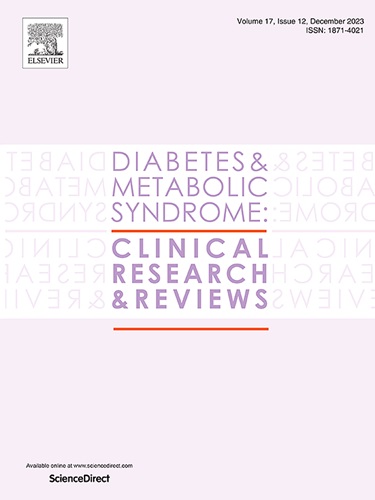Possible sarcopenia, sarcopenic obesity phenotypes and their association with diabetes: Evidence from LASI wave-1 (2017-18)
IF 3.4
Q1 ENDOCRINOLOGY & METABOLISM
Diabetes & Metabolic Syndrome-Clinical Research & Reviews
Pub Date : 2025-02-01
DOI:10.1016/j.dsx.2025.103185
引用次数: 0
Abstract
Aims
To assess the prevalence of possible sarcopenia and sarcopenic obesity phenotypes and investigate their association with self-reported diabetes among community-dwelling individuals aged 45 or above.
Methods
Utilizing data from 62,899 individuals in LASI wave-1 (2017-18), the assessment of possible sarcopenia was done on two critical parameters: muscle (handgrip) strength and physical performance (gait speed), following the 2019 guidelines from the Asian working group on sarcopenia (AWGS). BMI, WC, WHR, and WHtR defined sarcopenic obesity phenotypes. Binary logistic regression analysis explored the association of possible sarcopenia and sarcopenic obesity phenotypes with self-reported diabetes.
Results
The prevalence of possible sarcopenia and sarcopenic obesity defined by BMI was found to be 44.4 % and 10.6 %, respectively. Individuals with possible sarcopenia exhibited a 1.18 times higher likelihood of developing self-reported diabetes (p < 0.001), while those with sarcopenic obesity by BMI had significantly elevated odds (1.94, 95 % CI 1.81–2, p < 0.001) for self-reported diabetes.
Conclusions
Sarcopenia and sarcopenic obesity phenotypes may increase the risk of developing diabetes as we age. Therefore, it is imperative to formulate targeted preventive and therapeutic strategies to combat sarcopenia and diabetes among the aging population.
可能的肌肉减少症、肌肉减少型肥胖表型及其与糖尿病的关联:来自LASI wave-1的证据(2017-18)。
目的:评估45岁或以上社区居民中可能的肌肉减少症和肌肉减少型肥胖的患病率,并调查其与自我报告的糖尿病的关系。方法:根据亚洲肌肉减少症工作组(AWGS) 2019年指南,利用LASI波-1(2017-18)中62,899人的数据,根据两个关键参数:肌肉(握力)力量和身体表现(步态速度)对可能的肌肉减少症进行评估。BMI、WC、WHR和WHtR定义了肌肉减少型肥胖表型。二元logistic回归分析探讨了可能的肌肉减少症和肌肉减少型肥胖表型与自我报告的糖尿病之间的关系。结果:BMI定义的可能肌少症和肌少性肥胖患病率分别为44.4%和10.6%。可能患有肌肉减少症的个体自我报告患糖尿病的可能性高出1.18倍(p)结论:随着年龄的增长,肌肉减少症和肌肉减少型肥胖表型可能会增加患糖尿病的风险。因此,制定有针对性的预防和治疗策略来对抗老年人群中的肌肉减少症和糖尿病是势在必行的。
本文章由计算机程序翻译,如有差异,请以英文原文为准。
求助全文
约1分钟内获得全文
求助全文
来源期刊

Diabetes & Metabolic Syndrome-Clinical Research & Reviews
ENDOCRINOLOGY & METABOLISM-
CiteScore
22.90
自引率
2.00%
发文量
248
审稿时长
51 days
期刊介绍:
Diabetes and Metabolic Syndrome: Clinical Research and Reviews is the official journal of DiabetesIndia. It aims to provide a global platform for healthcare professionals, diabetes educators, and other stakeholders to submit their research on diabetes care.
Types of Publications:
Diabetes and Metabolic Syndrome: Clinical Research and Reviews publishes peer-reviewed original articles, reviews, short communications, case reports, letters to the Editor, and expert comments. Reviews and mini-reviews are particularly welcomed for areas within endocrinology undergoing rapid changes.
 求助内容:
求助内容: 应助结果提醒方式:
应助结果提醒方式:


